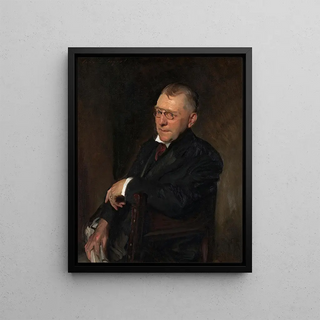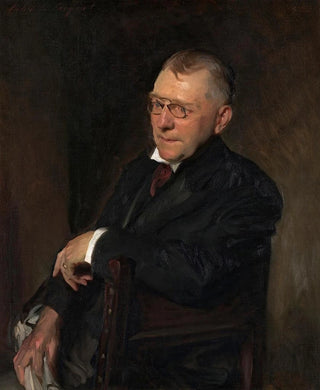Art print | Portrait of James Whitcomb Riley - John Singer Sargent


View from behind

Frame (optional)
Portrait of James Whitcomb Riley - John Singer Sargent – Captivating Introduction
The "Portrait of James Whitcomb Riley" by John Singer Sargent is an iconic work that transcends the simple frame of a portrait to immerse the viewer in the intimacy of a frozen moment. Created at the end of the 19th century, this painting is not only a tribute to one of the most celebrated poets of the era but also a subtle exploration of the nuances of human personality. By scrutinizing Riley's face, one perceives the depth of his thoughts and the richness of his creative universe. The art print of this work allows us to bring the magic of Sargent's painting into our living spaces, offering a window into America's literary and artistic history.
Style and uniqueness of the work
John Singer Sargent's style is often characterized by his technical virtuosity and keen sense of light. In the "Portrait of James Whitcomb Riley," Sargent deploys a delicate color palette that gives the canvas an atmosphere that is both warm and introspective. The way he captures the light on Riley's face, while playing with shadows, brings this representation to life. The details of the costume, carefully painted, testify to the attention paid to each element, thus revealing not only the poet's social status but also his character. Riley's slightly relaxed posture suggests a quiet confidence, an assurance that is reflected in his writings. This portrait, far from being a simple image, becomes a dialogue between the artist and the subject, a exchange that resonates through time.
The artist and his influence
John Singer Sargent, born in 1856, is often regarded as one of the greatest portraitists of his time. Trained in Paris and influenced by European masters, Sargent managed to integrate classical techniques while developing a personal style that is uniquely his own. His approach to portraiture goes beyond mere physical representation; he seeks to capture the very essence of his subjects. His collaboration with literary and artistic figures of his era, such as James Whitcomb Riley, demonstrates his central role in the cultural world of the late 19th century. Sargent not only redefined portraiture but also contributed to establishing a new sens

Matte finish

View from behind

Frame (optional)
Portrait of James Whitcomb Riley - John Singer Sargent – Captivating Introduction
The "Portrait of James Whitcomb Riley" by John Singer Sargent is an iconic work that transcends the simple frame of a portrait to immerse the viewer in the intimacy of a frozen moment. Created at the end of the 19th century, this painting is not only a tribute to one of the most celebrated poets of the era but also a subtle exploration of the nuances of human personality. By scrutinizing Riley's face, one perceives the depth of his thoughts and the richness of his creative universe. The art print of this work allows us to bring the magic of Sargent's painting into our living spaces, offering a window into America's literary and artistic history.
Style and uniqueness of the work
John Singer Sargent's style is often characterized by his technical virtuosity and keen sense of light. In the "Portrait of James Whitcomb Riley," Sargent deploys a delicate color palette that gives the canvas an atmosphere that is both warm and introspective. The way he captures the light on Riley's face, while playing with shadows, brings this representation to life. The details of the costume, carefully painted, testify to the attention paid to each element, thus revealing not only the poet's social status but also his character. Riley's slightly relaxed posture suggests a quiet confidence, an assurance that is reflected in his writings. This portrait, far from being a simple image, becomes a dialogue between the artist and the subject, a exchange that resonates through time.
The artist and his influence
John Singer Sargent, born in 1856, is often regarded as one of the greatest portraitists of his time. Trained in Paris and influenced by European masters, Sargent managed to integrate classical techniques while developing a personal style that is uniquely his own. His approach to portraiture goes beyond mere physical representation; he seeks to capture the very essence of his subjects. His collaboration with literary and artistic figures of his era, such as James Whitcomb Riley, demonstrates his central role in the cultural world of the late 19th century. Sargent not only redefined portraiture but also contributed to establishing a new sens






